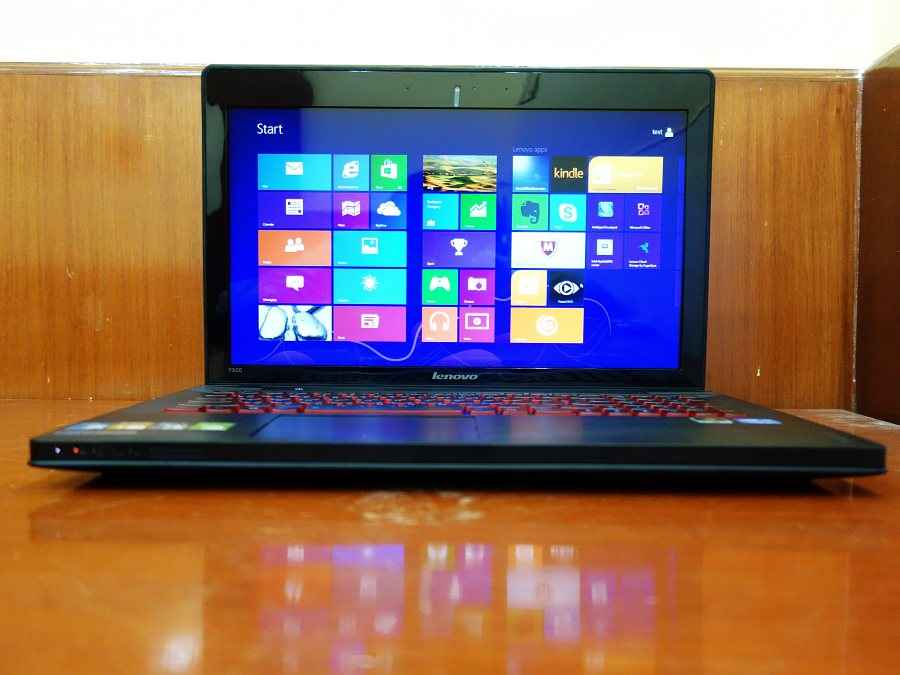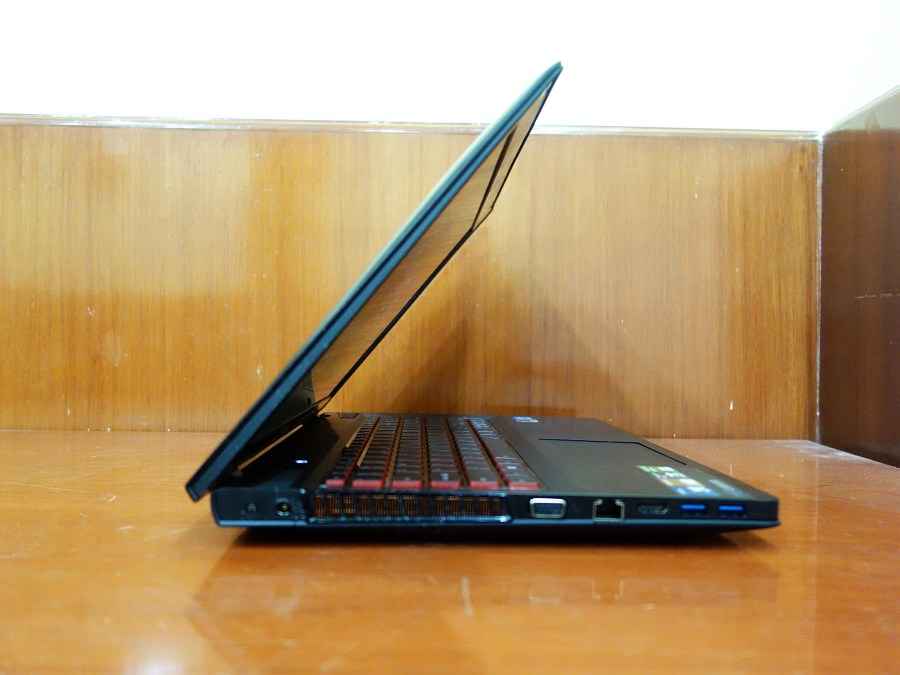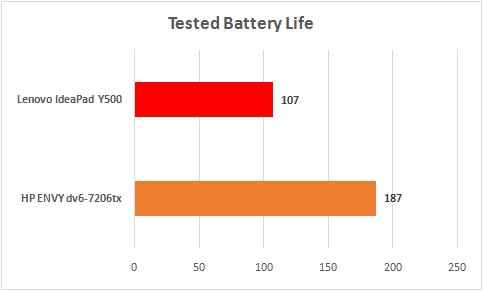Lenovo IdeaPad Y500 (59-346619) Review
The Lenovo IdeaPad Y500 runs a neck-to-neck battle with the HP ENVY dv6-7206tx in terms of performance. However, both machines have their unique points. The Y500 has a Full HD display, something that the ENVY dv6 does not offer. And also has a more powerful graphics card, considering the Y500 does have �gaming notebook� ambitions. But, the tests show that the ENVY dv6 offers better battery life, and has a much better keyboard. Buy the Y500, simply for the additional gaming capabilities, and the Full HD display, over the HP ENVY dv6. If these two aspects are not very critical for you, the dv6 will be a better deal.
Build & Design
When you do unbox the IdeaPad Y500 for the first time, you may wonder as to why we are saying that this could be a ‘gaming laptop’. The looks, the design and the overall persona don’t betray those ambitions as such.
The brushed-finish on the IdeaPad Y500’s aluminium lid looks very subtle and makes no noise about any intentions of standing out in a crowd. This same finish is carried on the keyboard deck as well. There seems to be a fair amount of differentiation between the various IdeaPad series. The Z500 has a soft finish, the older Z580 has a plain grey finish and now the Y500 with the dark brushed metal finish.
The good part about this kind of a colour option and the non-shiny finish is that you will not have to take a cloth to it every couple of hours to wipe off the dust. However, fingerprints do tend to show up more often on the IdeaPad Y500 than we would have liked, and that is a tad weird.
Open the lid, and now you get the subtle hints about what the configuration of the machine could be. The keyboard is the giveaway, with the chunky keys and the red backlighting. The speaker grills with their edgy design adds a bit of aggression to an otherwise subdued design.
The IdeaPad Y500’s side spines have all the connectivity options. The right spine hosts the optical drive, a USB port and dual 3.5mm headphone. This is something HP has been doing for quite a few years now, and it good to see other laptop makers implement this rather nifty feature, albeit very underrated. The left side has two more USB ports, the HDMI out, the Ethernet jack and a fairly generous sized cooling vent with the red grille, most likely to match the keyboard backlighting theme. The front near side spine has the memory card slot and a bunch of notification LEDs – power status, battery, caps lock etc.
While the build quality of the IdeaPad Y500 is good for the most part, there are a couple of issues. There is a certain amount of flex on the palm rest area, to the left of the touchpad. And unlike the HP ENVY dv6, the keyboard does not sit as a separate layer and there is a certain amount of dip if you press hard near the centre.
Overall, the IdeaPad Y500 could have been a lot different from what it actually looks like. The subtle and understated design does mean that it can be used in a boardroom without getting any glares. It would be equally comfortable in a teenager’s room, as a powerful gaming rig. We like the build quality for the most part, but there are a couple of rough edges that should not be present on an expensive machine. Lenovo needs to put a tad more focus on the build quality, because we had complained about the same thing with the expensive Lenovo IdeaPad Yoga 13 as well.
Features & Specifications
The Lenovo IdeaPad Y500 (59-346619) has considerable power under the hood. The processor is the Intel 3rd Gen Core i7-3632QM quad core processor clocking at 2.2GHz. The 8GB of RAM is becoming pretty much standard in this price bracket. Compare this to the HP ENVY dv6-7206tx which has an Intel Core i7-3630QM quad core processor clocking at 2.4GHz and also has 8GB of RAM to support it.
The IdeaPad Y500 has the Nvidia GeForce GT650M (2GB) graphics chip, at least in the version that we got for review and this is the same as sold in India. The HP ENVY dv6 does lag a bit behind in this regard, since it has an Nvidia GeForce GT630M (2GB), a chip that the Lenovo IdeaPad Z580 had when it was launched in autumn 2012. The Y500 has some serious gaming performance to offer, which we will explain with the benchmark tests in the performance section.
Why we would recommend the IdeaPad Y500 to anyone, at the drop of a hat, is because of the 15.6-inch display with the Full HD resolution. This is a spec that is still very rare, even among fairly expensive notebooks sold in India. While the Y500 does not have the IPS display with the 1080p HD resolution like the Sony Vaio S, its plain LED display does rather well. It scored well in the benchmark that tested the contrast quality. It also did well in the black level test, but did score slightly lower than expected in the white saturation test.
The IdeaPad Y500 has a 1TB hard drive, but does not have an SSD for caching tasks. Some of the higher spec versions being sold globally do have that as standard. We do hope that the next upgrade at least bumps up the drive from the current 5400rpm generation to the 7200rpm generation, considering the kind of performance the Y500 attempts to offer.
Lenovo packs in the 64-bit Windows 8 operating system on the Y500, but the best part about this is the very minimal preloaded trials and software on the machine. That is usually a huge problem with a lot of laptops, but apart from a few games and a couple of trials, the Windows 8 installation is fairly clean.
Performance
The Lenovo IdeaPad Y500 is pretty much neck-to-neck with its closest competitor, the HP ENVY dv6-7206tx, in terms of the benchmark tests. We ran a series of tests on both the machines, and as it turns out, the performance scores for both are absolutely neck and neck! You may have heard the phrase “too close to call”, but this is pretty much a tied test. One may take the lead in one test, the other will pip it in the nest one!
Our first benchmark test was the PC Mark 07 test, which is to purely test the system performance. Both machines have the Intel Core i7 processor, but fairly different ones. The Lenovo IdeaPad Y500 has the Intel Core i7-3632QM clocking at 2.2GHz while the HP ENVY dv6 is powered by the Intel Core i7-3630QM processor clocking at 2.4GHz. As the benchmark tests show, the performance difference is pretty huge, at least that is how the numbers look. A couple of reasons behind that – the difference in clock speeds is one reason, with the second being the 3630QM has a bigger thermal envelope letting it go up to 45W, while the 3632QM is limited by a to 35W TDP.
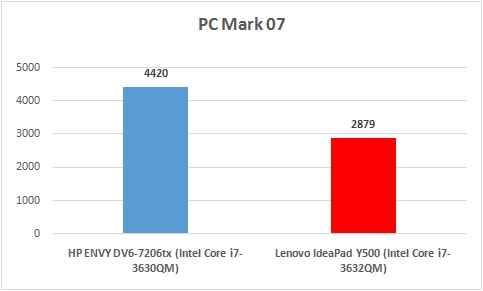 |
 |
In terms of real world usage scenario, both machines feel pretty much the same. The real difference, or the full impact of the power for that matter, will not be felt under most usage patterns. Boot times are similar, and apps open in similarly quick time.
But, where the IdeaPad Y500 has the undisputed advantage, is in the gaming aspect. While the HP ENVY dv6 that we are comparing the Y500 with is no slouch with the Nvidia GT630M (2GB) graphics chip, the IdeaPad just takes the lead thanks to the much more powerful Nvidia GeForce GT650M (2GB) chip. The basic difference between the two is that the GT650M’s core speed can go up to 850MHz within the boundaries, while the GT630M is limited at 672MHz. Memory speed remains the same across both – 900MHz. The Lenovo IdeaPad Y500 has the clear advantage in all the benchmark tests, including the Unigene and Cinebench tests that give out tested numbers for FPS. Essentially, if gaming is your priority, then for the same amount of money, the Y500 is what you should consider than the ENVY dv6.
 |
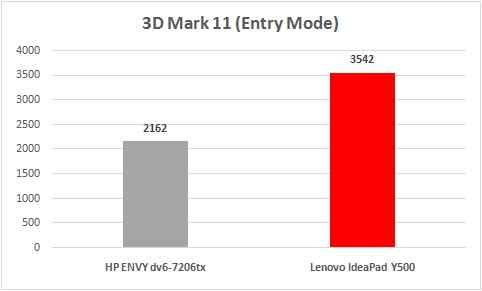 |
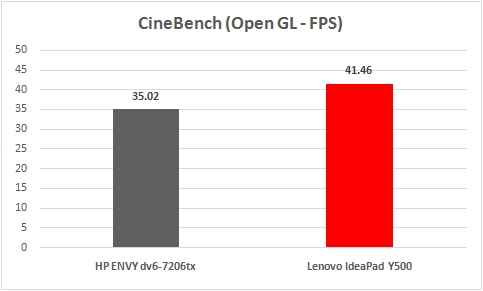 |
 |
Battery life is definitely better in the ENVY dv6, and our battery test clocked it at 187 minutes. The IdeaPad Y500, on the other hand, managed 107 minutes on a single charge. In a typical day at work routine, the Y500 will offer somewhere around 2.5 hours with the brightness turned down to around 30%. The ENVY dv6 will surely offer around 4 hours on a single charge, getting you through almost till lunch without the need to charge.
For anyone who will need the machine to type out long documents or mails quickly, the Lenovo IdeaPad Y500’s keyboard could pose a bit of a learning curve. First off, the key size is a little too big and chunky, resulting in a tad too much amount of travel. But, what you really need to get used to is the slight curve on the lower part of all the keys, more so if you are shifting over from a laptop that has keys in a perfect square design.
Bottom Line
The performance bit between the Lenovo IdeaPad Y500 and the HP ENVY dv6 is almost the same, and so is the market price (approx. Rs 66,000) of these two machines. But, while they are the closest in terms of competition, we believe that the two cater to fairly different user demographics. The IdeaPad Y500 is meant more for the user who is the power user and will use the machine for a considerable amount of gaming or fairly intensive designing work that requires a Full HD display. The dv6, on the other hand, is meant for someone who wants to do the balancing act – tiptoe between office and a spot of gaming every once in a while. But, for all the advantages of a better graphics card and a Full HD display, the Y500 does lose out with a couple of niggles with the way it is put together.

